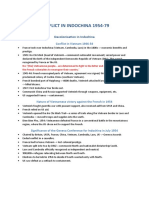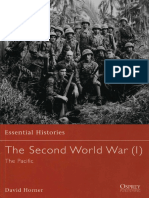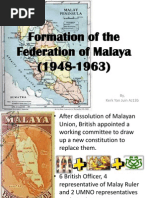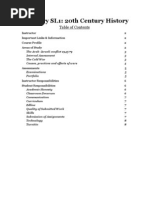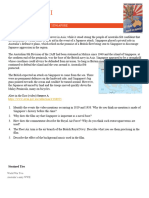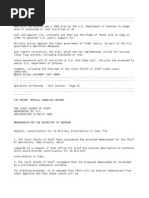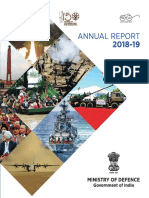Fall of Singapore
Fall of Singapore
Uploaded by
Abina MangaleswaranCopyright:
Available Formats
Fall of Singapore
Fall of Singapore
Uploaded by
Abina MangaleswaranCopyright
Available Formats
Share this document
Did you find this document useful?
Is this content inappropriate?
Copyright:
Available Formats
Fall of Singapore
Fall of Singapore
Uploaded by
Abina MangaleswaranCopyright:
Available Formats
Pearl Harbor and the Fall of Singapore The British did not abandon Singapore.
The British did not abandon Singapore. The British forces in Malaya, including
Hitler’s great success in Europe encouraged the Japanese to move south and the Australian 8th Division, tried to hold the advancing Japanese but were
take territory they felt was vital for Japan’s survival. Only the United States forced back across the Strait of Johore to Singapore itself. The island was, in
had the naval and military power to stop them. In 1941 the Japanese military fact, reinforced to the point where the Allied soldiers outnumbered the
leaders drew up plans for a Japanese attack on the United States Pacific fleet advancing Japanese. However, Singapore had little air defence and Japanese
at Pearl Harbor in the Hawaiian Islands, to be followed by a Japanese push air attacks caused widespread panic and loss of nerve. The Japanese air
south to Malaya, Singapore, the Philippines and the Dutch East Indies. A force was able to bomb the island and defence was poorly planned. Australian
Japanese attack force of six aircraft carriers and twenty-four warships sailed nurses were evacuated and the injured were treated in makeshift hospitals,
under strict radio silence from its base in Japan in late November 1941. By including inside Singapore’s St Andrew’s Cathedral.
the morning of 7 December 1941 the fleet had sailed undetected to within 400
kilometres of Pearl Harbor, and at dawn it launched its airborne attack. Seven On 15 February the British commander of Singapore, General Percival,
United States battleships were either sunk or damaged and over 2400 men surrendered. It was the largest surrender in British history, with 130 000 Allied
were killed. Fortunately for the United States, all four aircraft carriers were at soldiers, including 15 000 Australians, surrendering to the Japanese. Most of
sea on the morning of the attack and thus were undamaged. these Australians would endure the rest of the war in Japanese prison camps
and many thousands would die.
Following the attack on Pearl Harbor, which brought the United States and
Australia into the war against Japan, the Japanese began a swift advance
southwards. In the same week as Pearl Harbor the Japanese bombed Hong
Kong, Singapore and the Philippines, and a Japanese army landed in
northern Malaya and southern Thailand. On 10 December 1941 Japanese
aircraft sank the British battleship Prince of Wales and the battle cruiser
Repulse off the coast of Malaya. On Christmas Day Hong Kong fell and the
Japanese began their march down the Malay peninsula towards the vital
British base on the island fortress of Singapore.
The importance of Singapore for Australia’s security
Australia had always regarded the British naval base at Singapore as vital to
Australia’s security and as the front line of its defence. It was supposed to be
impregnable (unable to fall). Singapore was in fact well-defended for any
attack from the sea, but the Japanese advanced down the Malay peninsula
and approached Singapore from its undefended landward side. The island
was defended by over 130 000 British and Empire troops, and in early 1941
Australia had sent 15 000 men of the 8th Division AIF to assist in the defence
of Malaya and Singapore.
On 21 January 1942 the British prime minister, Winston Churchill, seriously
considered evacuating Singapore and concentrating British forces in nearby
Burma. The Australian government strongly opposed this idea. John Curtin,
who had become prime minister in October 1941, made the point clearly in a
dispatch to Churchill.
Reaction to the fall of Singapore
The fall of Singapore caused great concern in Australia. ‘Our honeymoon is
finished,’ said John Curtin. ‘I demand that every Australian everywhere realise
that Australia is now inside the fighting lines. It is now work or fight as we have
never worked or fought before. There must not be a man or a woman in this
Commonwealth who goes to bed tonight without having related his [or her]
period of wakefulness to the purpose of war.’
Australians had always feared invasion from the north, and they had always
believed that Britain would come to Australia’s aid if ever this fear became a
reality. Suddenly in 1942 the possibility of an attack on Australia or an
invasion appeared very real. The great British base at Singapore had fallen
and there was nothing to stop the Japanese advance.
Britain, strained to its limits in the war with Germany, was in no position to
help. Australia was also in a weakened position for its own defence. The
Australian navy had already lost three of its five cruisers in battle, three AIF
divisions were still far away in the Middle East, and 15 000 men of the 8th
Division had been captured by the Japanese in Singapore. Australia had its
Citizen Military Forces (militia) for home defence, no tanks, inadequate
weaponry, and a small air force that had been supplying pilots for the British
war effort. In 1942 Australia was isolated and not well defended.
5. What do these two
sources tell us about
the fall of Singapore?
You might also like
- Battles From The Age of Reason Version 3.3 Edition RulesDocument48 pagesBattles From The Age of Reason Version 3.3 Edition Rulesbrixio8baracus100% (3)
- The Cold War - David G. Williamson - Hodder 2013 PDFDocument329 pagesThe Cold War - David G. Williamson - Hodder 2013 PDFMohammed Yousuf0% (1)
- China From Empire To Peoples Republic 1900-49 (Michael Lynch)Document164 pagesChina From Empire To Peoples Republic 1900-49 (Michael Lynch)zhao.liangfeng100% (2)
- Battlegroup - WestwallDocument70 pagesBattlegroup - WestwallFOW100% (5)
- Government Surveillance Thesis StatementDocument7 pagesGovernment Surveillance Thesis Statementashleygomezalbuquerque100% (1)
- Access To History Mark Robson - Access To History. Italy The Rise of Fascism 1915-1945-HoDocument161 pagesAccess To History Mark Robson - Access To History. Italy The Rise of Fascism 1915-1945-HoWincy Lee100% (1)
- Access To History Politics Presidency and Society in The Usa 1968-2001 1st Edition PDFDocument241 pagesAccess To History Politics Presidency and Society in The Usa 1968-2001 1st Edition PDFAndrijaNo ratings yet
- Life in The Trenches of WwiDocument25 pagesLife in The Trenches of Wwiapi-265023521No ratings yet
- IB History of EUROPE AND THE MIDDLE EAST PDFDocument15 pagesIB History of EUROPE AND THE MIDDLE EAST PDFRicardo Pérez De La Torre100% (1)
- Sample-Chapter-For Superpower-relations-and-the-Cold-War,-1941-91,-Student-Book PDFDocument19 pagesSample-Chapter-For Superpower-relations-and-the-Cold-War,-1941-91,-Student-Book PDFTha Libra Fraudster100% (1)
- Aqa 7041 7042 SP 2015 PDFDocument86 pagesAqa 7041 7042 SP 2015 PDFEleni Hannam0% (1)
- Excel Year 12 Modern History Online Resource 2019Document63 pagesExcel Year 12 Modern History Online Resource 2019TomNo ratings yet
- Osprey - Essential Histories 008 - The Korean War 1950-1953 (Osprey Essential Histories 08) PDFDocument95 pagesOsprey - Essential Histories 008 - The Korean War 1950-1953 (Osprey Essential Histories 08) PDFMiguel Angel Martinez Fernandez100% (4)
- A Bitter FateDocument154 pagesA Bitter FateIan MorleyNo ratings yet
- Fall of SingaporeDocument2 pagesFall of Singaporexzran100% (1)
- Fall of Singapore PPT 2Document24 pagesFall of Singapore PPT 2Glenn Wong100% (1)
- CH 32 Sec 2 - Japan's Pacific Campaign PDFDocument5 pagesCH 32 Sec 2 - Japan's Pacific Campaign PDFMrEHsieh100% (2)
- Textbook:history Vietnam War PDFDocument100 pagesTextbook:history Vietnam War PDFUpasna Khastgir100% (2)
- 2019 MH Conflict in Indochina 1954 79 Notes Chloe McMillanDocument17 pages2019 MH Conflict in Indochina 1954 79 Notes Chloe McMillanPriscaNo ratings yet
- This Resource Supports The Holocaust PowerpointDocument11 pagesThis Resource Supports The Holocaust PowerpointLaura Martínez Andero100% (2)
- Power & Authority in The Modern World Cambridge Neale & Bright 2018Document232 pagesPower & Authority in The Modern World Cambridge Neale & Bright 2018Mac FosterNo ratings yet
- 11 History Themes in World History Goalias BlogspotDocument260 pages11 History Themes in World History Goalias BlogspotShamim SaifiNo ratings yet
- Schindlers List Viewing GuideDocument9 pagesSchindlers List Viewing Guideapi-355895504No ratings yet
- IB Cold War TimelineDocument13 pagesIB Cold War TimelinemarkjaradehNo ratings yet
- Origins of The Vietnam War Part OneDocument3 pagesOrigins of The Vietnam War Part OneNick Shepley100% (1)
- The British EmpireDocument123 pagesThe British EmpireLuis Quiaro100% (3)
- Grest War - 1 World WarDocument26 pagesGrest War - 1 World WarAjay Pratap Singh100% (1)
- Modern World HistoryDocument125 pagesModern World HistoryMallikarjun ReddyNo ratings yet
- Great Battles in Australian HistoryDocument445 pagesGreat Battles in Australian HistoryИвар Ковалевский100% (2)
- The Cold War: in This Module You Will LearnDocument34 pagesThe Cold War: in This Module You Will LearnSapna KawatNo ratings yet
- Biomes and Food Production Oxfam ActivityDocument3 pagesBiomes and Food Production Oxfam Activityapi-29507180682% (11)
- The First World War (2) The Western Front 1914-1916Document94 pagesThe First World War (2) The Western Front 1914-1916Zoltán VassNo ratings yet
- Hitler's Foreign PolicyDocument18 pagesHitler's Foreign PolicyRyan Keeney100% (1)
- History For The IB Diploma Paper 3 The Cold Wars and The AmericasDocument50 pagesHistory For The IB Diploma Paper 3 The Cold Wars and The AmericasJaskeerat100% (2)
- Cold War StationsDocument77 pagesCold War Stationsapi-340511893No ratings yet
- Imperial Japanese Army PDFDocument14 pagesImperial Japanese Army PDFdzimmer6100% (1)
- 018 - The Second World War (1) Pacific PDFDocument96 pages018 - The Second World War (1) Pacific PDFCelio Neto100% (3)
- The Japanese Occupation of MalayaDocument51 pagesThe Japanese Occupation of MalayaSekolah Menengah Rimba100% (14)
- French Revolution NotesDocument138 pagesFrench Revolution Noteskwezi kennedyNo ratings yet
- Political Impact of The Treaty of VersaillesDocument20 pagesPolitical Impact of The Treaty of VersaillesArtemis Entreri100% (1)
- Formation of The Federation of Malaya (1948-1963Document12 pagesFormation of The Federation of Malaya (1948-1963Choo Siew Mee100% (1)
- Physical Geography of AsiaDocument26 pagesPhysical Geography of AsiaII-2 Saint ClareNo ratings yet
- Sea Raiders of MalayaDocument115 pagesSea Raiders of MalayaScott Abel100% (1)
- Edexcel IGCSE Superpowers 1943 72 v2cDocument77 pagesEdexcel IGCSE Superpowers 1943 72 v2c?????? ????100% (2)
- Year 11 History Unit PlanDocument16 pagesYear 11 History Unit Planapi-360769022100% (1)
- All About History - The Battle of JutlandDocument2 pagesAll About History - The Battle of Jutland128931095123100% (1)
- Tamils History in SriLankaDocument48 pagesTamils History in SriLankaasutha100% (24)
- Ebin - Pub Fascist Italy SHP Advanced History Core Texts 1nbsped 0719573432 9780719573415Document284 pagesEbin - Pub Fascist Italy SHP Advanced History Core Texts 1nbsped 0719573432 9780719573415krystellNo ratings yet
- Persian Wars WorkbookletDocument43 pagesPersian Wars Workbookletapi-262912520100% (1)
- World War I PowerPointDocument72 pagesWorld War I PowerPointNayeem Patwary100% (2)
- CIA - Analysis of The Korean WarDocument48 pagesCIA - Analysis of The Korean WaroraberaNo ratings yet
- Age of ImperialismDocument30 pagesAge of ImperialismAjay Pratap Singh100% (2)
- 0522852505Document304 pages0522852505Oleksandra GaidaiNo ratings yet
- Unit Plan - Cold WarDocument19 pagesUnit Plan - Cold Warapi-340511893No ratings yet
- Bоok of the Cold WarDocument164 pagesBоok of the Cold WarNguyễn Hoàng Hải67% (3)
- IB History SL1: 20th Century HistoryDocument8 pagesIB History SL1: 20th Century HistoryDrCharlesGleek100% (2)
- History & Social Science Class 9 English VersionDocument192 pagesHistory & Social Science Class 9 English Versionnaeemcomputer02100% (1)
- A Brief History of US-ROK Alliance and Anti Americanism in South KoreaDocument48 pagesA Brief History of US-ROK Alliance and Anti Americanism in South KoreaBogan de Boganville100% (1)
- Fall of SingaporeDocument3 pagesFall of Singapore76153No ratings yet
- Battle of Singapore PDFDocument15 pagesBattle of Singapore PDFdzimmer6100% (2)
- Chap 5 Part II 2015Document49 pagesChap 5 Part II 2015Glenn WongNo ratings yet
- History Y2Document26 pagesHistory Y2xinyan02272No ratings yet
- Gabriel Navarrete Article5-30-15 PDFDocument3 pagesGabriel Navarrete Article5-30-15 PDFEditorNo ratings yet
- Fdsk2-The Story of Easy CompanyDocument1 pageFdsk2-The Story of Easy Companyskippygoat11No ratings yet
- Air Assault Operations - FM 90-4 - U.S. Army - 01MAR11Document110 pagesAir Assault Operations - FM 90-4 - U.S. Army - 01MAR11Mafer Figueredo0% (1)
- OPERATION NORTHWOODS Full-Text 1962USA-MADE TOP SECRET TERRORIST FALSE FLAG OPERATION: "CUBA PROJECT"Document17 pagesOPERATION NORTHWOODS Full-Text 1962USA-MADE TOP SECRET TERRORIST FALSE FLAG OPERATION: "CUBA PROJECT"hulksmaash100% (10)
- 158th Field Artillery Official Extract No. 171Document332 pages158th Field Artillery Official Extract No. 171John JensonNo ratings yet
- Indo-Israel Realtions and ApkistanDocument6 pagesIndo-Israel Realtions and ApkistanMuzaffar Abbas SipraNo ratings yet
- B3L4038 Engineering in The Offense and DefenseDocument31 pagesB3L4038 Engineering in The Offense and Defenselone survivor100% (3)
- NATO Backfile 2Document142 pagesNATO Backfile 2Han JNo ratings yet
- Η εισβολή της Ρωσίας στην ΟυκρανίαDocument7 pagesΗ εισβολή της Ρωσίας στην ΟυκρανίαARISTEIDIS VIKETOSNo ratings yet
- MoDAR2018 PDFDocument280 pagesMoDAR2018 PDFPraveen KalliguddiNo ratings yet
- Wa0008.Document8 pagesWa0008.jyotika singhNo ratings yet
- FoW Armoured Fist 16 84Document69 pagesFoW Armoured Fist 16 84Alex ZNo ratings yet
- Q Uestions The Battle of Gettysburg: Reading Section Practice TestDocument6 pagesQ Uestions The Battle of Gettysburg: Reading Section Practice TestJorgeChahinNo ratings yet
- MCIP 3-10a.3i 199Document1 pageMCIP 3-10a.3i 199DR LuotanNo ratings yet
- Uganda National Action Plan 2017Document44 pagesUganda National Action Plan 2017umar koireNo ratings yet
- Cluster Munitions A Banned Weapon English - April 2014Document2 pagesCluster Munitions A Banned Weapon English - April 2014molepe3891No ratings yet
- The African Stakes of The Congo WarDocument262 pagesThe African Stakes of The Congo WarReferencista BibliotecaNo ratings yet
- Cordon and Search OperationsDocument31 pagesCordon and Search OperationsNipunaNo ratings yet
- Lw3 West Italy Poles-ItalyDocument26 pagesLw3 West Italy Poles-Italytsar1701No ratings yet
- Paul M. McGarr - Spying in South Asia - Britain, The United States, and India's Secret Cold War-Cambridge University Press (2024)Document360 pagesPaul M. McGarr - Spying in South Asia - Britain, The United States, and India's Secret Cold War-Cambridge University Press (2024)Heather CarterNo ratings yet
- Tna 09-24 19931129Document42 pagesTna 09-24 19931129federalexpressionNo ratings yet
- Essentials of Field Craft Survival: Aryssa Jane SalmorinDocument32 pagesEssentials of Field Craft Survival: Aryssa Jane Salmorinpearl100% (1)
- Thayer Vietnam People's Army's Double Mission'Document8 pagesThayer Vietnam People's Army's Double Mission'Carlyle Alan ThayerNo ratings yet
- 2566 10151 4 PBDocument23 pages2566 10151 4 PBArthi GaddipatiNo ratings yet
- Request For Allotment of Governmet Surplus / Waste Land To Serving Armed Forces PersonnelDocument2 pagesRequest For Allotment of Governmet Surplus / Waste Land To Serving Armed Forces Personnelraj23.sutarNo ratings yet
- LWD 3-4-1, Employment of ArtilleryyDocument234 pagesLWD 3-4-1, Employment of Artilleryykruger69420100% (1)
- Operational Law in International Straits and Current Maritime Security Challenges Jörg Schildknecht all chapter instant downloadDocument65 pagesOperational Law in International Straits and Current Maritime Security Challenges Jörg Schildknecht all chapter instant downloadgerasserlidaNo ratings yet


















